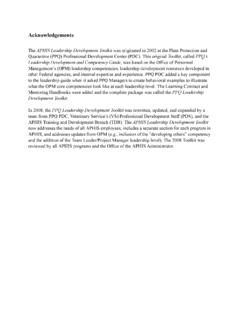Transcription of Community-based Approaches to Reducing STDs
1 Community-based Approaches to Reducing STDs Community Engagement Toolkit Authors and Acknowledgments Authors Shaunt S. Wright Jo A. Valentine Norman A. Hayes David B. Johnson Nixon R. Arauz Acknowledgements Gail Bolan Scott Rhodes Jason Daniel-Ulloa Sheena Simmons Megan Cotter Los Angeles County STD Program/ Health Research Association University of TX Health Science Center at San Antonio Urban Affairs Coalition (UAC) YOACAP Virginia State Department of Health (Richmond City Health District) AIDS Foundation of Chicago City of Baltimore Department of Health Public Health Management Corporation University of Michigan Cicatelli and Associates Inc. Capacity Builders Inc. San Diego State University Foundation Wake Forest University Health Sciences Suggested citation Centers for Disease Control and Prevention.
2 Community Approaches to Reducing STDs: Community Engagement Toolkit. Atlanta: Department of Health and Human Services, Centers for Disease Control and Prevention, National Center for HIV/AIDS, Viral Hepatitis, STDs, and TB Prevention, Division of STD Prevention, Office of Health Equity; 2019. 1 Foreword 3 STD Prevention: 4 Maximizing the role of communities How to use this toolkit 7 CARS Implementation Model 9 Conduct a Community Health Needs Assessment 9 Establish a Community Advisory 11 Train CAB Members 14 Facilitate CAB Review of Additional CHNA Components 16 Engage CAB in Social Determinant of Health Prioritization 18 Support CAB STD Intervention 20 Implement Interventions 22 Evaluate Community Engagement, 24 Build and Ensure Sustainability through Partnerships 26 Celebrate Successes with CAB and Partners 28 Appendix 29 Foreword Sexually Transmitted Diseases (STDs)
3 Remain one of the most critical public health challenges facing the United States ( ), with approximately 20 million new STD infections occurring every year. Nearly half of these new infection occurs in young people ages 15-24. Centers for Disease Control and Prevention (CDC) STD surveillance data shows that there are higher rates of reported STDs among some racial or minority populations when compared to rates among whites. Health disparities in STDs are linked to a complex blend of social determinants that influence which populations are most severely affected by these diseases. Health equity entails focused efforts to improve the health of those who experience social or economic barriers to achieving health. The Community-based Approaches to Reducing Sexually Transmitted Diseases (CARS) initiative is funded by the Division of Sexually Transmitted Disease (STD) Prevention (DSTDP) in the National Center for HIV/AIDS, Viral Hepatitis, STD, and TB Prevention (NCHHSTP) at the Centers for Disease Control and Prevention (CDC).
4 The program was established in 2011 to support the planning , implementation, and evaluation of innovative projects that: 1) Reduce STD disparities; 2) Promote sexual (personal) health; and 3) Advance community wellness. The CARS initiative uses community engagement methods to achieve health equity. Health equity is achieved when everyone has an equal chance to be healthy regardless of his or her race/ethnicity, sexual orientation, or social class. Learning more about the individual and social factors that sustain STD epidemics is a vital first step in assisting affected communities to improve their health status. To prevent and control STDs, communities need quality health information and services. By identifying and implementing systems and environmental change strategies that promote sexual (personal) health and support healthy behaviors, the CARS initiative facilitates community-clinical linkages to support interventions to prevent and reduce STD disparities.
5 The program seeks to enhance and sustain partnerships and support communication strategies that promote STD prevention activities. This toolkit was developed to make available the lessons learned from the CARS initiative to organizations interested in implementing community engagement as a strategy, particularly for STD prevention and control. We encourage you to use this toolkit to identify and implement interventions tailored to the needs of your respective target communities and populations to reduce the incidence of STDs and improve their health status. Sincerely, Jo Valentine, Associate Director for Health Equity CDC, Division of Sexually Transmitted Disease 3 STD Prevention: Maximizing the Roles of Communities The current epidemic of sexually transmitted diseases (STDs) disproportionately affects disadvantaged ethnic an d sexual minority groups.
6 The social marginalization of persons at risk for STDs can leave these groups suspicious and distrustful of interactions with government authorities such as health departments, which can impede their access to much needed STD prevention and control In response, many STD programs are working to involve their respective focus populations in the development and delivery of STD prevention and control interventions, thereby better informing outreach efforts and enhancing service delivery. 2-5 However, history, especially when it s recent, is not soon forgotten. Sometimes the best intentions end up paving that proverbial road no one wants to Yet, it does make sense to collaborate with communities and groups disproportionately impacted by STDs to improve STD program effectiveness. 7 Increasingly, partnerships between health institutions and the communities they serve are regarded as essential to achieving health But what does that mean?
7 Communities burdened b y STD disparities are more than the collection of statistics that describe their health problems or individual risk behaviors. T he meaning of community varies, and not just by census tract. The definition of community entails cultural identity and social experiences ( , gay men, high school adolescents, or migratory farm workers).8 The commonly s hared social determinants of health that are unique to individual communities or groups are important to understand, as they can be either barriers to or facilitators of health. Such determinants should govern the nature and scope of the community engagement effort. So, what is community engagement for STD prevention and control? How can potential STD patients become powerful STD prevention partners to protect the community s health? The lessons learned from the implementation of the Community-based Approaches to Reducing STDs (CARS) Project provide a practical roadmap to engaging with communities to prevent and control STDs.
8 Community engagement is not only a n end, but it is also a means. It is both an outcome and a dynamic process. Levels of engagement are likely to change based on content and context, and the persons There will be times when c ommunity expertise will be more vital than professional expertise, but there will also be times when t he reverse will be true. More often t han not equal parts of both are necessary. In other words, community engagement usually requires a both-and approach as opposed to either-or. As a strategy, community engagement is popular with a variety of health and social programs, and researchers10-12. Public H ealth programs, in particular, increasingly rely on involving members of underserved, disadvantaged communities in the implementation of health promotion efforts. S tudies show that community engagement improves intervention effectiveness and suggest that the strategy also supports intervention The traditional sudden arrival of professional experts, implementing quick if culturally and even contextually indifferent fixes, usually followed by abrupt withdrawals when the funds run out, often leave the targeted communities and groups frustrated a nd underserved.
9 Typically, these methods at best involve community members as staff, or in the case of research, as subjects, but rarely allo w for community decision-making power in the design, delivery or 4 evaluation of intervention activities. A community s only power is usually limited t o the right of refusal to participate in the program or study, all too often to the community s detriment because needed services were not utilized. Instructed by such less ons, many Public H ealth programs now strive to ensure that the communities they seek to serve are not merely passive consumers of services, but that they are also partners in health. Community engagement has become not only a strategy, but a fundamental goal.
10 To be most effective, community engagement efforts should be guided b y the principles of authentic p Community engagement has to be pragmatic. What kind and how much community participation can the program reasonably accommodate? One size will not fit all. Programs are obliged to set realistic objectives for all of their partnerships. T he level of community engagement is based on t he degree of community- or focus-group power in relationship to the external institutions seeking to engage with them,15 and includes careful consideration of public h ealth laws and grant management regulations. The higher rates of STDs among some racial/ethnic an d sexual minority groups are not caused by ethnicity or heritage, or sexual orientation. Moreover, the risk for infection is not exclusively a function of individual behavior.


















